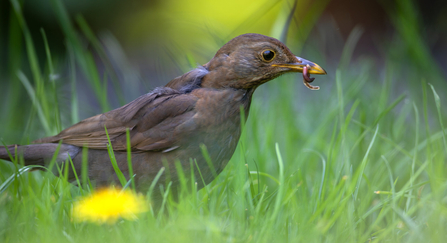
Blackbird © Jon Hawkins - Surrey Hills Photography
A few well-chosen plants transform Ed's front garden

Blackbird © Jon Hawkins - Surrey Hills Photography
Our garden birds are laying their first clutch of eggs and will soon have hungry babies to feed! Robins, blackbirds and song thrushes are often the first to hatch, followed by great tits and blue tits.
For these early birds, the biggest threat to their survival is lack of food, or to be precise, the right type of food, which is usually live insects. You can help your early birds by putting out live mealworms on your bird feeder.
Compost heap by Charlotte Evetts
It’s time to feed your trees and shrubs with a mulch of compost that you’ve made during the autumn and winter. Take care when emptying and turning compost heaps to make sure hedgehogs and grass snakes (which love the warmth of compost) have moved out.

Wild flower meadow, Corn cockle, Corn flower, Centaurea montana, Agrostemma githago, Poppy, Papaver rhoeas, Sheffield - Paul Hobson
Create your own mini meadow of bright and colourful annual flowers that the bees and butterflies will love. Red poppies, blue cornflowers, mauve corncockles, golden tagetes and yellow corn marigolds will brighten up your borders and veg patches from summer into autumn.
Sow seeds now direct onto prepared soil, water them in and cover with sticks to make sure you remember where the patch is before the seedlings emerge.
Create a buzz - flowers for bees and butterflies (https://youtu.be/NJVu4lxksgc)
Create a buzz - flowers for bees and butterflies

A nesting house martin. Picture: Margaret Holland
Swifts and house martins are now red listed and need as much help as possible. Did you know that these amazing summer visitors will eat up to 20,000 flying insects per day including mosquitoes, gnats, and flying ants?
These three species are dependent on humans to build their nests; swifts nest in crevices under eaves, whereas house martins and swallows will build their nests out of mud, under the eaves of houses and porches. The decline of suitable nesting sites, increasingly drier summers, and lack of insects has meant that these birds are now struggling to breed successfully.
You can buy readymade swift nest boxes and artificial nest cups for house martins and swallows from various suppliers. Place well-tucked under north or west facing eaves, at least 3m high for swifts and 2m high for house martins and swallows.